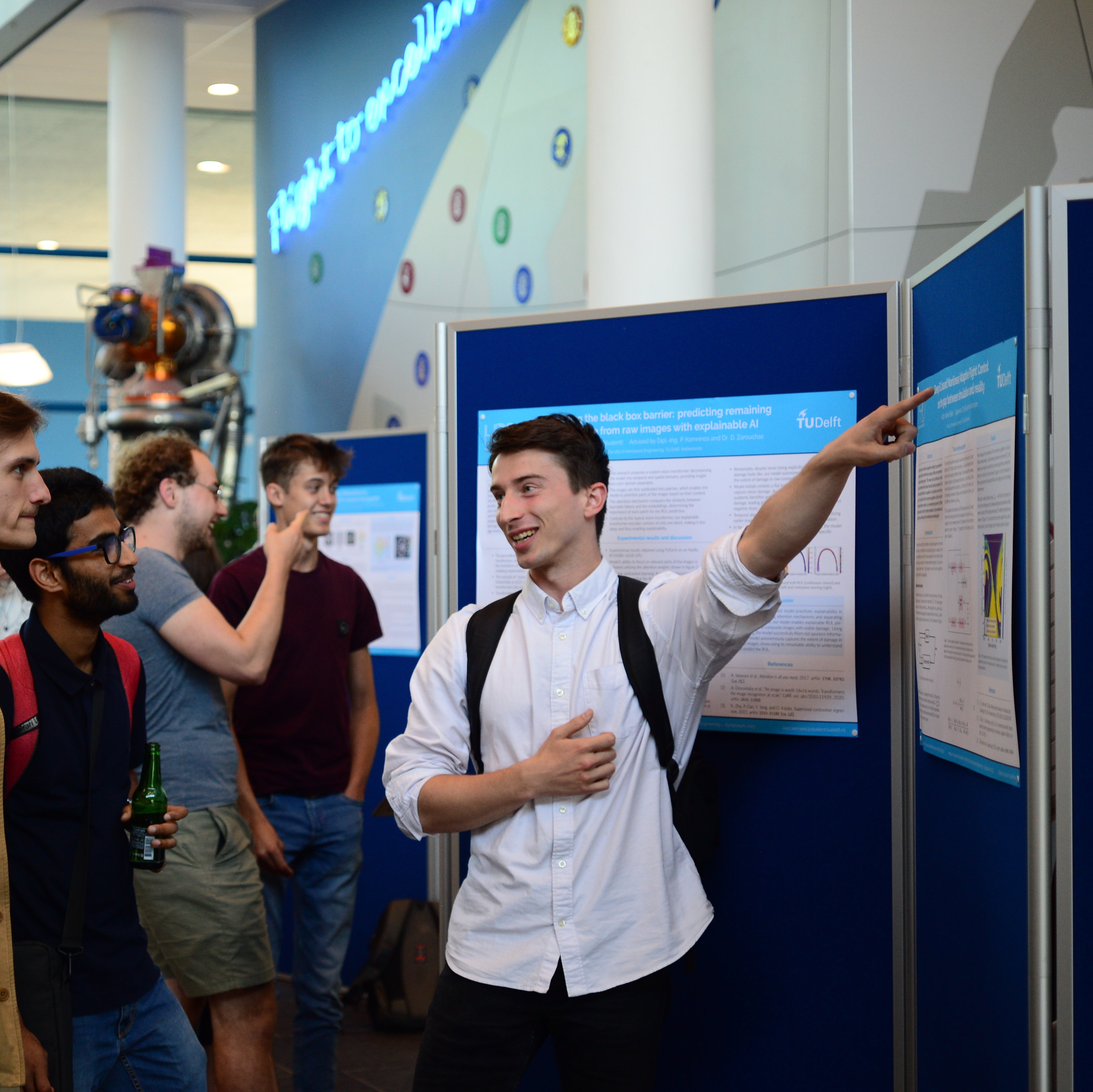Symposium 2023
On 14 June 2023 the HPB students presented the results of their research projects during the yearly symposium. The symposium started with a short introduction by the dean Henry Werij. After that 3 students gave a presentation of their research project, the results and the lessons they learned. The presentations were followed by a poster session in the central hall of the Aerospace building. A few of the research projects are presented below. You can also watch the video that was made during the symposium: https://www.youtube.com/watch?v=eXEOEBZdiCA
An evaluation of methods and assumptions used in potential flow modelling of swirl recovery vanes
Abstract:
Various potential flow methods with different assumptions are available to quantify the efficiency increase and thrust provided by a swirl recovery vane (SRV). In this paper, thrust coefficients and efficiency results obtained by different potential flow methods for the same SRV geometry at different advance ratios are presented. The methods include two VLM and four lifting line (LL) models with different assumptions. The models are compared in terms of accuracy with respect to RANS results and computational cost. This makes it possible to evaluate the benefits and drawbacks of neglecting or accounting for the presence of certain effects and modelling choices. The effects taken into account or deliberately neglected in different models include; finite propeller-SRV distance, nacelle presence, wake and free stream nonalignment, flow interaction between vane blades, the Kutta condition and SRV sweep. The wake angle behind the SRV is also varied and its effect on thrust coefficient is observed. In conclusion, accounting for the presence of a nacelle and finite slipstream distance respectively leads to 7.28% and 16.39% improvement in accuracy of the SRV thrust coefficient with negligible increase in CPU time. Not aligning the SRV wake with free stream direction has little impact on the computed thrust coefficient but causes the CPU time to increase steeply. Using a VLM based model rather a LL model and modelling vane interaction significantly increases CPU time whilst yielding the highest improvements in thrust coefficient accuracy (25.43% and 35.16%).
High-accuracy radiation pressure models for the Lunar Reconnaissance Orbiter
Abstract:
Centimeter-scale orbit determination is necessary for satellite navigation and spaceborne geodesy. Orbits are sensitive to perturbations such as radiation pressure (RP) due to solar radiation as well as planetary albedo and thermal emissions. This project investigated sensitivities of orbit predictions to varying complexity in RP models for the Lunar Reconnaissance Orbiter (LRO). We found that solar RP dominates but lunar RP affects secular variations in semi-major axis and argument of periapsis. A constant-albedo lunar model and a paneled LRO model are recommended for precise radial and along-track positioning.
Entropic MRT Lattice Boltzmann Model (KBC) & application on VPLBM
Abstract:
The lattice Boltzmann method (LBM) is an alternative approach to computational fluid dynamics based on a fully discrete kinetic equation and fluid populations. The classical LBM scheme is ’weakly compressible’. It was also (LBGK) plagued by numerical instabilities in highly turbulent flows unless a more extensive domain or smaller time scale was used to increase resolution. Several improvements of LBM attempted to negate this issue. In articular, the multiple relaxation-times methods (MRT) take advantage of the additional degrees of freedom in the LBM kinetic system to stabilize the solution and improve accuracy. However, the MRT scheme introduced tuneable constants unique to each physical system, thus not a general solution for stability. With the introduction of ELBM (Entropic Lattice Boltzmann) that mimics Boltzmann’s H theorem in discrete time, simulations of highly turbulent and thermal flows were possible. However, ELBM introduces varied viscosity over the domain, which can be negative. The smoke simulations and high turbulence flows require a stable scheme and preserved fine-grid details. As mentioned, for regular LBM to solve these systems, resolutions need to be increased further. Work by Wen[1] has tackled this problem by checking local flow properties at each point and artificially adding a decrease in these properties back to mesh. Although this solution works with three non-coupled meshes, it still does not tackle the stability problem but only solves the preservation problem. This report aims to solve the problem of creating a lattice method that, while preserving vorticity, tackles the stability issue with an ELBM and uses lower resolutions.
Development of an aircraft taxiing BlueSky plug-in using ground traffic data for taxiway direction determination
Abstract:
BlueSky is meant as a tool to perform research on Air Traffic Management and Air Traffic Flows, developed as an open-source software. The aircraft taxiing plug-in is developed to deepen the completeness of the tool, and allow ground-traffic simulation. The chosen approach is to create graphs for each airport, on which the trajectory planning plug-in will work. A global path planning tool uses A* to generate the path of an aircraft on ground. A tactical approach is used for aircraft collision avoidance, by adjusting the speed of aircraft on a collision trajectory. For a realistic functioning of the plug-in, determining the taxiway directions of each edge in the graphs is necessary. This can be analysed by using data obtained from OpenSky to analyse ground-movement patterns and determine taxiway directions from these.
Deep Reinforcement Learning based Nonlinear Adaptive Flight Control
Abstract:
The need for adaptive robust flight controllers has become apparent as the systems which must be controlled have substantially grown in complexity. One could continue trying to design ever more complex architectures of, for example, cascaded PID control laws, but this approach is inefficient for a highly nonlinear systems. Another problem faced by modern controllers is the lack of knowledge of the plant dynamics. Although high-fidelity system models could be developed to better approximate the true system dynamics, these attempts usually cannot keep the pace with complex aerodynamical phenomena experienced by modern aircraft, such as fighters or drones, not to mention their imperative unavailability before the first flight. Lastly, it cannot always be assumed that the system dynamics does not change during the flight. Adaptability is one of the crucial properties of future flight controllers, which will help cross the bridge between simulation and reality. One of the recent approaches to tackle the problem of high-dimensionality and nonlinearity is deep reinforcement learning (DRL). One of the approaches to tackle the problem of adaptability is incremental model based heuristic dynamic programming (IHDP). This research proposes to bridge the gap between simulation and reality by combining traditional DRL with IHDP. A novel corrective algorithm is proposed, which can online safely fine-tune crude offline-learned control laws.
Life Cycle Analysis of different Hydrogen Production Methods
Abstract:
Hydrogen is considered a vital component in the transition towards a sustainable world. However, a majority of the hydrogen produced globally is not environmentally friendly, and it generates even more emissions than burning fossil fuels alone. Therefore, it is crucial to differentiate between different types of hydrogen and analyze their life cycle to obtain a comprehensive understanding of their cost and emissions. This study aims to provide representative estimates of the cost and emissions associated with various hydrogen production methods. The findings reveal that the lowest emissions were observed in hydrogen produced from electricity generated by wind turbines, at 0.67 [kg of $CO_2$ eq per kg $H_2$], and hydrogen produced from electricity generated by nuclear power, at 0.73 [kg of $CO_2$ eq per kg $H_2$]. However, these methods were considerably more expensive compared to hydrogen produced through steam methane reforming, which costs 2.28 [USD/kg]. The price of hydrogen produced from nuclear energy is around 6 [USD/kg], while hydrogen from wind turbines is priced at approximately 5.1 [USD/kg].
Reliability Based Design Optimization of a Long-Range eVTOL Aircraft under Uncertain Mission Parameters
Abstract:
The emerging market of Urban Air Mobility (UAM) introduces highly uncertain mission parameters due to the non-conformal aspects of the expected operation of Electrical Vertical Take-off and Landing (eVTOL) vehicles, Unmanned Traffic Management (UTM) and vertiport logistics. The present research proposes a methodology to quantify this operational uncertainty, while integrating it into the design of an eVTOL aircraft by means of a Reliability-based Design and Optimization (RBDO) approach. The baseline configuration is a long-range eVTOL named Wigeon, which was deterministically designed and optimized. The proposed stochastic-based MADO approach employs a Monte Carlo Simulation to estimate the energy requirements for a diverse range of mission parameters. The results indicate that the reliability driven method performs better at mitigating risk compared to the traditional method of using safety factors to create design margin. However, the RBDO method overall lacks a significant advantage over the deterministic optimisation due to the dominance of the cruising phase in the overall energy consumption. Leading, the lift-to-drag ratio to be the driving parameter to the overall energy efficiency. The study also highlights that the adoption of RBDO comes with added computational costs, and more sensitivity to local minima.
Tomographic Background-Oriented Schlieren for Visualizing Supersonic Nozzle Flows
Abstract:
The Tomographic Background-Oriented Schlieren (TBOS) technique is a flow visualization technique that can be used to visualize supersonic flows. In this project, TBOS was experimentally applied to the supersonic jet of a sub-scale rocket nozzle to reveal the underlying characteristics of the flow. This could help further the understanding of unsteady flows occurring during the start-up and shut-down phases of rocket nozzles.
Robustness Analysis of Incremental Nonlinear Dynamic Inversion Control
Abstract:
The aerospace industry commonly uses proven technologies due to the long and expensive procedures of getting new technologies flight certified. Current research is ahead of what is actually implemented in industry. Often, matured and flight proven technology is also preferred as to mitigate risks of new technology failing. Specifically for fixed-wing aircraft, use is made of classical control techniques, such as PID controllers with gain scheduling. However, the introduction of digital flight control systems (FCS) has allowed for more of the advanced flight control systems (AFCS) to be implemented on aircraft which allows for better handling qualities and performance. Of special interest to this research is the development of incremental nonlinear dynamic inversion (INDI) as flight control.










